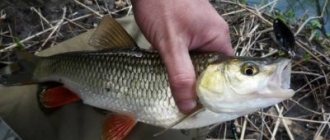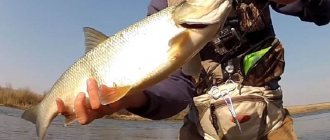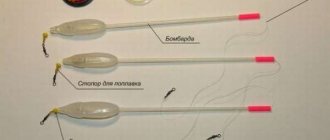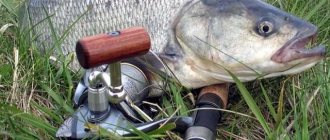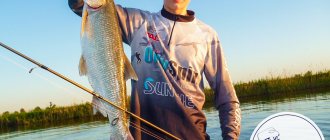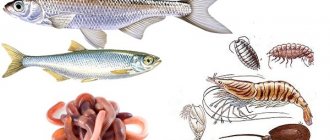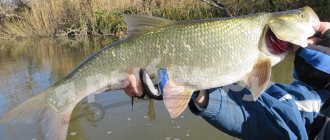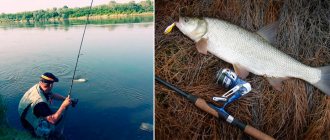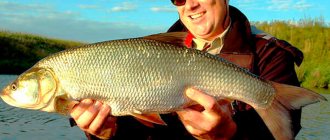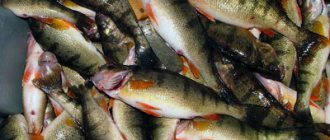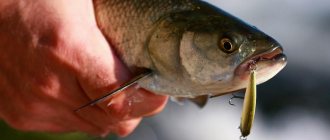Yuri 06.11.2020 588
Since the asp acts as a rather aggressive toothless predator, not all baits are suitable for it. The lack of teeth forces him to feed on fry. To catch this predator, fishermen often use live bait. Since catching a good fry can be a lot of trouble, we present to your attention the best artificial baits for asp. Experienced Astrakhan fishermen have learned to select lures in accordance with the preferences of the predator, and we are ready to pass on this interesting experience to novice spinners.
To make baits, metal or silicone is used - small fish with 1 or several hooks. The presence of a variety of baits in the angler’s arsenal increases the likelihood of leaving with a decent catch.
- Interesting fact! When hunting for fry, the asp jumps out of the water and makes a slap sound to scare its prey. The fry freezes in fear, and the asp only needs to catch him in the mouth.
Devonian
Since the asp lives in the upper layers of reservoirs, a spoon called Devon is suitable for it. The bait is available in various modifications - cylindrical, flat or square. The cylindrical Devon has blades on the sides that allow the spoon to rotate. Lures are available in silver or gold colors - made of metal. Additional weight is not required, since a length from 40 to 120 mm with a diameter of 20-35 mm indicates an impressive weight of the bait.
The market is gradually replenished with plastic models - their popularity among asp fishing enthusiasts is increasing. However, plastic Devon does not yet allow achieving the same effectiveness as a metal bait. In Devon there is one large tee, or two hooks on the sides. With such a bait it is easy to achieve accurate long-distance casting. We reel in the fishing line - the spinner rotates, imitating the movement of a small fish. The Volga is a deep river with a strong current, so it is better to use Devon “Meteor” or “Bumblebee” here.
Devon spinner for fishing
Disadvantage: during the wiring process, the fishing line gets very twisted, but the problem is solved with a swivel. To increase the service life of such a spoon, we store the Devon dry without drops of water, having previously blown the bait through. Drops may remain in the bearings - this can damage the rotation.
Button
We continue the series - the best baits for catching asp, we present to your attention a do-it-yourself bait - this is a round button with wire loops and a central thickening. The bait is easy to deliver to a given target; it adheres to a given flight path. The casting distance is determined by the weight, maximum – 80 m. The nozzle is equipped with a triple hook and feathers of a certain color scheme.
Spinner button for asp
For such a bait, the subtleties of wiring should be taken into account. To fish the upper and middle layers of water, fast active fishing is used. At the same time, when moving quickly, air bubbles form behind the button, to which the asp, rest assured, will react like never before.
Tactics and fishing techniques
Depending on the time of year, the specific fishing location and fishing habits, you can choose one of several tackles - fly fishing, spinning rod, float rod. Regardless of which gear you prefer, you need to know the subtleties to increase the likelihood of successful fishing.
Fly fishing
Having arrived on shore, you need to develop a suitable plan of action. At the beginning of summer, the predator gathers in schools, driving the fry, and collective hunting is used, which shows the high level of intelligence of the fish. By finding a cauldron (a place where a school of asp drives the fry) and throwing gear there, you can count on a good catch. In such cases the bite follows immediately. If you can’t find the boiler, you need to cast the fly onto the rapids, and not into the active stream of the current, but to the border where the flow is not so rapid.
Many fishermen disagree on whether the asp takes the fly right away or waits until the current brings it under his nose. Try both options - let the bait move with the flow of water, without relaxing for a second - be prepared for a sharp hook.
Spinning
There are no preferences in choosing fishing line. Monofilament, braided - depends on habits. The optimal diameter is 0.2-0.3 mm. This fish does not have sharp teeth like pike perch or pike, and a metal leash is not needed. As bait for catching asp, it is advisable to have several baits on hand - the preferences of the predator change sharply and unexpectedly. A spoon that caught a great bite a week ago may turn out to be useless today.
The castmaster for asp is popular - due to its large weight, it can be thrown over a considerable distance. Bombarda, known as sbirulino, performed well. A large float pulls the bait, which in strong currents and shallow depths jumps over the rocks, like a fish looking for edible insects. The asp probably won't resist. Vladimir Struev talks interestingly about this bait in the video below.
Experienced fishermen do not forget proven spoons. A spoon weighing 30-45 g helps out in cases where other baits are useless. A small wolfer can also be a good choice.
You should approach fishing carefully. For example, when hunting for pike, fans of spinning rods try fishing through different layers of water. If the target is an asp, it makes sense to give preference to the upper and middle wires - he rarely hunts below. Therefore, after casting the bait, either start retrieving it immediately or after a second so that the spoon or castmaster does not have time to lie on the bottom.
Float rod
Asps are caught relatively rarely with this tackle, although there are such masters. They can be understood - cautious fish rarely bite the bait, but the process of catching even a kilogram specimen will bring a whole range of feelings. It is not advisable to use a fishing line thicker than 0.3 mm - this will scare away wary fish. But if a specimen weighing 5-7 kilograms is tempted by the bait, it will not be easy to pull it out.
The fishing rod should be long - at least 3.5 meters, and preferably more. There are no special requirements for it; it is better to take the most convenient one. Inertia-free will allow you to make long casts and eliminate the possibility of the line getting tangled. Finally, the float. It’s better to take a transparent one - it’s almost invisible, which means it won’t attract unnecessary attention. True, these are not always available for sale, so some craftsmen use homemade floats.
When casting, try not to get too close to the water; stay against the backdrop of bushes and not in open areas. A strong, brave, but cautious asp, having noticed the shadow or silhouette of a fisherman, may well go to another place. That is why it is better to choose a long fishing rod - you can cast bait without coming close to the coastline.
The asp always offers fierce resistance to the fisherman. A spinning player should always remember about his strength and intransigence, especially when configuring the tackle.
Spring asp is the best fish for hunting. Believe me, every fisherman dreams of catching such a fish, and not just a simple one, but a bigger one! And such a spinner as the castmaster will cope with this task perfectly. This is exactly the type of spinner that you can customize for yourself. If you wish, you can even make a spinner yourself, however, here it all depends on your personal abilities and dexterity of hands.
Tips for fisherman: How to fry asp caviar in a frying pan - Choosing the best
The main advantage of castmasters is excellent aerodynamics during flight. Even a novice spinning angler can cast this bait far. Metal models fly best: pipe sections, jigs, triangular baits. And the wiring needed is quite simple. Uniform, rapid winding of the reel leads to the capture of the first asps. And then you can master the “step”, catching during the falling phase of the bait or during a pause from the bottom.
There are several basic ways to wire a castmaster. Firstly, high-speed uniform winding gives a good result. And although seasoned spinners consider it primitive, it is quite prey. The castmaster's long casting and high speed fishing in a certain water horizon are all the secrets of this fishing.
To catch a trophy asp, experienced fishermen use a little trick. The castmaster is thrown into the intended location of the boiler in advance. The bait lies on the bottom until the asp hunt begins. This maneuver of the spinning rod misleads even the most cautious individuals.
So why not try it? Even if the fly catches only a small fish, the extra tails still won’t hurt, and the pleasure is worth it.
The simplest, and therefore probably the most common, combinations are those with a fly in front of the main bait. Here the chase effect is used in a visual form, where the “pursued” small fly can imitate both an insect and a fry (Fig. 1) . Therefore, not only predatory and semi-predatory fish are caught with this combination, but also purely peaceful ones - such as bleak, roach and bream.
Unlike the “spinner-spinner” duo, the combination with a fly has its own characteristics. The main difference is a pair of fundamentally different baits. Many anglers are confident that flies most accurately reproduce the real food of almost all fish. By the way, I think so myself. Therefore, if a large main bait (spoon or wobbler) is initially “programmed” for one or two specific predators, then, in principle, anyone can bite on the fly - from bleak to seasoned pike.
Again, a paradox: the “toothy” one often ignores large baits, but takes a small fly, which it doesn’t even feel the taste of. The asp, which just yesterday grabbed the castmaster almost in the air, today does not see it point-blank and is caught only with a wabik. And salmon in summer generally clearly prefers salmon flies to all spinners and wobblers. As you can see, a small addition to the gear can bring a very big result.
So why not try it? Even if the fly catches only a small fish, the extra tails still won’t hurt, and the pleasure is worth it.
Equipment for such combinations can be different: both standard and special (Fig. 2) .
It all depends on how realistic the pike bite is and for what exactly. For example, if we catch an asp on a castmaster or a salmon on a spinner, then the probability of a “toothy” bite is negligible, and metal leashes are clearly not needed. Therefore, here flies are usually attached either directly to the main fishing line (Fig. 2a) or on its loops (Fig. 2b) - after all, both the flies and the main bait are “targeted” at the same large fish.
If you are hunting for pike and perch, and only “striped” ones are taken on a small fly, then there is no need for a second metal leash. But if a large streamer is used as an additive, it is risky to catch without “metal”. Therefore, in such cases, I usually make a special double leader from leader material (Fig. 2d) , leaving a 10-15 cm long branch on the swivel knot for tying a specific fly or a small fastener.
I would like to especially note that the combination with a fly is the optimal equipment both for reconnaissance in unfamiliar places and for catching a wide variety of fish. Therefore, do not be lazy and prepare at least a couple of appropriate flies for your next fishing trip. And then there will be no fish left in the pond, which, in principle, will be able to avoid getting to know you.
To choose the right supplement, you need to consider several factors. If we want to catch anything that bites, a fly in the form of a nymph or larva would be optimal. For obvious predators, a streamer, including the largest ones, is better suited. However, it should be remembered that a volume fly, due to its braking effect, can negatively affect the main bait. Therefore, with a wobbler or jig, they usually put one small “short” fly or something similar, for example, a phosphorus spinner (Fig. 3) .
But a fairly heavy jig or spinner with a weight head will “pull out” almost any additive. Nevertheless, here too I recommend, first of all, to try the flies. After all, even peaceful fish will bite on a nymph or an imitation of a bloodworm, and seasoned predators may also be coveted by a large streamer. Moreover, here too, what is caught with the supplement often exceeds the catch with the main bait. Imagine, this could happen on your next fishing trip, and we don’t have the right flies!
True, a twister, octopus or foam fry can be no less effective in this case. If we remember that the twister is an active bait, the octopus is semi-active, and the foam rubber is passive, it becomes clear: the first is more likely to manifest itself when the predator is actively biting, the second - when the predator is actively biting, and the third - when the predator is weak.
In my personal practice, luck smiled more often on the next two “duets” (Fig. 4) .
Although, depending on the specific situation on the pond, any pair of baits may be optimal. True, the “ideal” will have to be selected experimentally, and for this you need to at least try several basic combinations. But is it necessary to prepare all of them at home or can you “compile” them while fishing? To answer this question, you need to remember about the equipment.
Since when bottom fishing the probability of a pike bite is especially high, both baits should have a metal leash: either a soft one made of leash material, or a semi-rigid one made of thin wire. Then, if you put fasteners on the ends of both leashes, you can quickly replace both the main and auxiliary baits.
Victor Andreev, “Original spinning baits”
Devon-turbines for asp also have all the necessary qualities for catching this white predator. Retrieving when fishing with Devon turbines is done quickly and evenly. The only disadvantage of this spoon is that it will only work with high-tech production and requires constant care.
Pinwheel
How to choose the right spinner for an asp? More on this later. The bait is distinguished by the presence of a petal that rotates around its axis, there is also a hook and a tail section. Strong hydroacoustic vibration is generated during rotation. The lateral line of a predator perfectly transmits the signal to attack. The asp's frequent landings on the spinner indicate two things - either he perceives the spinner as a fry, or it irritates him. It's up to you to decide, but the fact remains that the turntables in Astrakhan work for asp, especially in the fall.
Asp spinners
The efficiency of catching asp on a spinner increases if you alternate slow and fast retrieves. Two or three slow turns are followed by two or three quick jerks of the reel. If we go fishing in sunny weather, then the best spinner for asp is copper color; cloudy weather requires the use of silver shades.
What to fish with
Spinning
Spinning is the ideal tackle for catching this fish in the summer. It attacks the bait not from an ambush, but, as it were, by stealth. That is, it catches up with the bait that it noticed. That's why they make long casts.
Gear selection
Take two-handed spinning rods up to 3 m long and a high-speed reel. Use a monofilament line no larger than 0.25 mm in diameter. The color of the fishing line is selected to suit the location. The main thing is that it is not unnoticeable in the water.
If a large trophy is expected, then it is better not to increase the thickness of the fishing line, but to make it stronger. Otherwise, a thick fishing line will affect the play of the spoon and will be noticeable to the fish.
The best baits for fishing
The bait is taken based on the river robber’s favorite delicacies: not large, narrow and silvery. For example, long-range spinner spoons with a narrow blade and weight.
Another option is a spinner spoon - Kastmaster from Acme Tackle. There are not many options with shakers that the asp would like. Some spinners are included in separate subparagraphs in the article due to the peculiarities of their wiring.
If it is not possible to use the variations of spinners listed below, then it is better to focus on spinners similar to those of the Kastmaster. There are also primitive options, but they are very catchy. This is a spinner in the form of an oblique cut of a cylinder and a triangular spinner.
Choosing bait depending on fishing conditions and time
On clear days, spinners are taken with a yellowish (golden) and copper tint. In cloudy weather, when it gets dark and in the morning, white and silver colors are suitable.
How to catch asp using a spinning rod
First, they fish upstream in those areas where the asp presumably lives. They start with close casts, gradually increasing them.
The cast is made immediately instead of “fighting” the asp. Place the bait in the direction the fish is moving, and not in the place where the “fight” was noticeable.
The bait is placed near the upper layers of water in spring and summer, and along the bottom in autumn. The asp grabs the cutting bait and greedily. When fishing for this predator, the main thing is to tire it out. But do not overdo it, otherwise the line will not withstand the pressure of the asp.
First, they fish upstream in those areas where the asp is supposed to live.
Float tackle
Gear selection
The float is installed transparent, in the shape of a ball. By the way, there are floats on sale specifically for float fishing for asp. This can be water-filled or with a special load. But it is best to buy water-based ones.
The line is from 0.2 to 0.3 mm in diameter. Hooks size 7-10.
The rod must be strong and not shorter than 3.6 m. The reel must be installed without inertia for long-distance casting of bait. The reel clutch is adjusted to the sharp impacts of the asp.
Lures for fishing
The following are used as hook bait: chafers, bleak, perch, tadpoles, small frogs. The distance from the bait to the float must be at least one meter.
After casting, the rig is released with the flow, gradually releasing the line. It is best to cast from a bridge or boat. If you use small fish, then make long casts. They hook the baitfish by the lips.
Lures depending on fishing conditions and time
The requirements for baits are the same as when equipping a spinning rod, but you can also use dark ones with bright splashes of other colors, as well as baits with iridescent colors.
Bombard
This equipment is ideal for spring and autumn fishing. The bombard has fewer hooks compared to other equipment. The tackle is not equipped with a sinker and a float.
The asp bites on the bombard in a variety of ways: with a strong blow when fishing against the current, with gentle pokes when fishing behind the current or with a sharp jerk. If the retrieve is slow, then the fish bites smoothly and accurately.
Gear selection
They use a spinning rod with dough in the range from 15 g to 55 g, three meters long, a spinning reel with a reserve of 3000 or 4000, a braided cord 0.16 mm in diameter, compact spinners of 20-30 g (preferably castmasters) with turbines, monofilament leads of 0.25-0.3 mm. The longer the leash, the better the bait plays. That is why leashes are taken up to one meter long.
The bombards themselves weigh 25-35 g with a durable antenna. For outdoor fishing, it is enough to take 3 pieces. Two white and one dark. This one in case of poor visibility.
The bombard is strung on a cord, after which an 8 mm plastic bead is put on. A triple swivel of increased size is secured with a blind loop. The bead will protect the fisherman from getting the bombard antenna stuck in the swivel.
There is a small note about the length of the spinning rod. Can also be used in 3.3 m lengths, but experience is required. Yes, and beginners can use reels of size 2500 from any manufacturer. The clutch is set to release easily. The turbines take 1.3 g zeros, similar to Aglia Mepps with yellow petals.
With this style of fishing, the main thing is range. The cast can be made vertically and smoothly, or sideways with a slight slope.
The second option will be dynamic: first, the tackle is placed behind the back, and the rod is set at a low angle. When the bait swings back, the rod is tilted even lower. And when the bait stops at the maximum distance from the fisherman, they make a swing.
If you are casting into a narrow place, then with your left hand you take the bait by the tee and make a pendulum cast. 3-5 meters before the bait touches the water, slow down the line. Often caught between the catches are asp and chub and perch. I cast with a fan.
Lures for fishing
The tackle is equipped with turbine spinners adapted for bombards. The bait is taken tens of times easier by the bombard itself.
The asp bites on a bombard in a variety of ways: with a strong blow when fishing against the current, with gentle pokes when fishing behind the current or with a sharp jerk.
Fly fishing
They begin fly fishing from the moment insects appear. The gear is used in small rivers overgrown with grass. Any bait that stays near the surface will also work.
Therefore, fly fishing can be done in places with fast currents and dense underwater vegetation. Throw the bait across the current or 45 degrees downstream.
If they make the first casting option, then the fisherman stands opposite the asp’s stand and also lowers the bait to the side of the predator’s stand. In this case, it is more convenient to catch fish.
In another case of casting, the fisherman stands above the parking lot. It will be difficult to fish, and if there are underwater shelters or thick algae, then it is better to refuse such casts. Asp actively bite after rain or during high water when fly fishing. At the riffles, the water seems to boil during such periods.
Gear selection
The rods take 5-7 (9) fast and medium-fast action, torpedo-shaped line with a short head.
Lures for fishing
For fishing, natural baits are used (very catchy large grasshopper and chafer), light or white streamer like bleak and dace (RM's Floating Streamer, Little Fry, White Fry). You can also take primitive furrows, dry flies of light colors (Elk Hair Caddis). They fish with flies on top, and with insects at the surface and in mid-water.
Bait is carried out in the usual way.
Spreader for asp
The oscillator does not produce rotations, but vibrations. A wounded small fish makes similar movements, which is what the predator most often reacts to. A metal plate is in the shape of a fish, and the tail has a hook - that’s the whole structure of the vibrator.
- Interesting! Some fishermen make their own oscillating spoons and apply the desired pattern to a metal plate, imitating scales, eyes and gills with a single color.
Oscillating spoon
To fish the upper layers of water, where our predator prefers to hunt, it is better to use lightweight spoons - their weight does not exceed 30 g and their length does not exceed 5 cm. It is recommended to start by fishing places with weak currents. Fishing in strong currents requires heavy bait. Experienced fishermen recommend using the “Pig” spoon. The spoon-shaped shape and slight bend lures predators better. His attention is attracted by the ringing and sharp cast into the pond. It is difficult to throw such a bait into windows between grass or water lilies, then the next bait comes to the rescue.
Catching asp with a bombard
Catching an asp with a bombard is carried out mainly when the asp is caught on baits that do not fly far. Spinners - “spinners”, small wobblers, spoons and flies, are used very often when catching asp. However, it is impossible to throw a light “spinner” far, and here the bombarda comes to our aid - an excellent tackle invented by the Italians.
Tips for fisherman: Astrakhan balyk recipe in Astrakhan - How to best use
Naturally, the tackle becomes heavier and this should be taken into account when choosing a rod for this method of fishing. The weight of a bombard to deliver a small spinner over a decent distance is somewhere in the range of 20-40 grams and therefore the rod should have a test slightly larger than the casting tackle and have a length of at least 3 meters. Ideally 3.30-3.60 meters.
The length of the leash should be within 1-2 meters without a steel leash, since the asp has no teeth. The wiring should be done evenly, as with normal wiring of a turntable. The cast must be done softly to avoid overlap. Using a bombard, you can also catch asp using streamers, flies, artificial insects, beetles and other small predator baits.
Equipment for catching asp using a bombard
Catching asp with live bait
Catching asp with live bait is done from a boat using float gear. Bleak or gudgeon are usually used as live bait. The gear for fishing with live bait is assembled like this: we need a spinning rod or a short rod with rings and equipped with a reel with monofilament fishing line (diameter should be no more than 0.25 mm), a float with a carrying capacity sufficient to prevent the live bait from drowning it.
A sinker (the sinker should hold the bait at the set depth) and a double or tee on a leash. The diameter of the leash should be in the range of 018-020 mm, this is quite enough for competent fishing of a trophy specimen.
This way you can catch asp on rifts and shallow rapids; you need to stand on a boat in front of the desired place and float the bait tackle downstream to a promising place. A prerequisite is that the live bait must be alive and nothing should hinder its movement, so hook it to the ridge with one of the hooks.
Catching asp with a wobbler
Catching an asp with a wobbler is done in approximately the same way as with live bait, the only difference being that instead of using live bait, you float a floating wobbler with a slight depth downstream just below the desired location and only after that start fishing.
Wobbler for catching asp
If you are fishing from the shore, you also need to float the wobbler downstream to the desired location and then only do the wiring. Agree that there cannot be many such places on the river bank, but if there are, then use this opportunity. I will finish here and can only add that here we present the most popular and proven methods of catching asp by more than one fisherman. See you again!
We have already talked about the main asp baits that most fishermen use. However, such a topic as catching asp with a streamer, or as our Ukrainian colleagues say, with a beard, is not very common among Belarusian fishermen. And by the way, in vain. After all, when the asp is not active for various reasons, and he does not show much desire to chase jigs, kukri and castmasters, then it is then that a rig using a streamer (barb) can become a lifesaver.
We have already talked about the main asp baits that most fishermen use. However, such a topic as catching asp with a streamer, or as our Ukrainian colleagues say, with a beard, is not very common among Belarusian fishermen. And by the way, in vain. After all, when the asp is not active for various reasons, and he does not show much desire to chase jigs, kukri and castmasters, then it is then that a rig using a streamer (barb) can become a lifesaver.
You can fish with a streamer using sbirulino, or you can additionally tie it on a short leash (branch) above the main bait. We will not touch on fishing with sbirulino for now, because this is a separate topic for discussion and we will leave it for later. Therefore, for now, let’s look in more detail at how to properly tie the equipment, where we will hang our streamer above the main bait.
So, in order to properly connect the installation, we will need fluorocarbon with an average diameter of 0.3 millimeters, swivels and carabiners, and, of course, the streamers themselves. There are two options for equipment, which are mostly used by foal fishermen, and which I use myself. They may differ minimally in their characteristics, such as the length of the leash itself, the length of the outlet, the thickness of fluorocarbon, etc., but in general the principle remains the same.
The diameter of the leader depends on the bait: from 0.16 mm for the smallest ones (small wobblers or “spinners” do not work well on thick fishing line) to 0.22 mm for larger ones.
The main problem when catching asp is its good eyesight. Having noticed the silhouette of a man on the shore, he continues to beat the fry, but at the same time he examines the object of the hunt very carefully and refuses to grab any artificial imitation. There are two ways out: either hide very well, or throw it very far. Or better yet, both.
Compact lures
Long-distance casting requires compact baits, such as Cas, Devons and other heavy (weighing at least 20 g) spinners, but if you hide well and, in addition, catch a tailwind, you can even throw a suspended wobbler to the asp.
For asp, river sand spits are a favorite hunting spot in summer. Perhaps this is explained by the fact that it is on the sands that various pelagic “white” fish feed, such as bleak and sabrefish, which the asp is a big hunter of.
The main thing when catching asp is to behave in such a way that the fish does not even suspect your presence in the pond.
It is advisable to place the spinner on the water as quietly as possible, slowing down the descent of the line at the end of the cast, and then perform the retrieve.
When the asp actively strikes from above, the working one most often turns out to be high-speed wiring; if he hunts in the middle layers - stepped. In the latter case, the Kastmaster models are very good, they sink shallowly and often roll from side to side during a pause.
If there is no “fight”, then by conducting wiring in different layers of water, you can try to determine at what depth the asp is hunting today.
Tips for fisherman: Asp balyk at home recipe - How to best use
Spinner baits that have not yet been tested must be tested first. So, “Castmaster” must have a pronounced game. If it hangs in the water “like a sausage” or goes into a tailspin during a fast retrieve, it is better to abandon it. If the spinner works fine during testing, you can safely use it, even if the cost of the bait is “penny”.
"Spread"
Let's look at the two most different equipment from each other.
"Castmaster" + streamer.
A “Kastmaster” is tied to a piece of thick (0.3-0.4 mm) monofilament line, a knot is made half a meter above it, a swivel is placed behind it and another knot is tied 2-3 cm from the first. The swivel “runs” freely along the line between the limiting nodes. If the size of the knots is too small, you can put a couple more beads between them and the swivel. With this installation, the equipment gets less tangled. A short (5-10 cm) leash made of thinner monofilament or fluorocarbon with a wobble is tied to the swivel.
This type of equipment works best for fast reeling in the upper and middle layers.
To knit streamers, you can use both improvised materials (wool, Christmas tree “rain”) and special fly fishing materials.
In the second case, after casting, the baits are first allowed to go somewhat deeper and only then they begin to reel in.
The wabik (streamer) is knitted on a tee or double hook No. 4-6 (according to the “Ovner” numbering). Wabiki are made in different colors; Sometimes dark ones work better, sometimes light ones.
If a twister is installed instead of a wabik, the leash can be made slightly longer, and high-speed wiring can be alternated with slower or stepped wiring.
Usually, when fishing with this equipment, in 80% of cases the asp of pressed rivers takes the bait on a leash; with the Kastmaster, bites generally follow only with a good bite. However, there are also “doublets”, when the fish is caught on both baits at once.
Bombard.
The “Sbirulino” rig with a bombard is inferior to the “Kasmaster” rig in casting range, but allows for slower retrieving, which means. and the use, in addition to wobblers and twisters, of such baits as small “spinners”, wobblers, oscillating micro-spoons.
To catch asp on large rivers, long casting is required, so bombards weighing 15-25 g are relevant.
For fishing on riffles and sand bars, it is better to use slowly sinking bombards - the current will still bring them to the surface when reeling in.
It is difficult to pass a wet “braid” through a bombard, so I pre-mount it on a piece of thick (0.35 mm) monofilament or braided fishing line of the appropriate length with camels at both ends. I tie a base (“braid”) to one, and a leash made of monofilament or fluorocarbon to the other. This helps, if necessary, to quickly replace the bombard with a lighter (or heavier) one or with other equipment.
The maximum length of the leash is desirable: 15-20 cm less than the length of the rod (so that you can stick the bait hooks into the cork handle when moving from place to place) - there is no vegetation on the sand spits that would interfere with casting equipment with a long leash.
The diameter of the leader depends on the bait: from 0.16 mm for the smallest ones (small wobblers or “spinners” do not work well on thick fishing line) to 0.22 mm for larger ones.
The wiring also depends on the bait. The “spinner” works on a uniform retrieve, and a bombard with a wobbler can be driven either evenly or with smooth pulls with pauses. A streamer can be used in the same way, but at a higher speed.
The advantage of a bombard is that it can be floated several tens of meters downstream. In this case, it is possible to fish not only by reeling, but also by floating, holding the line coming off the spool with your finger (the bait then goes in front of the bombard). At the same time, there is a chance to catch a chub, ide or perch, which are located below the spit.
Don't repeat yourself!
When fishing for asp and chub, which often stay close together, it is important to follow two basic rules.
Seasonality
From an article by Vladimir Balovnev (“Fishing with us” 11/2012)
The length of the spinning rod for fishing from the shore is 2.7-3.30 meters; from a boat it is more convenient to fish with a blank of 2.1-2.4 m. A fast-action carbon spinning rod with a length of 3.0 and a dough of 50 grams is the optimal choice.
Wobbler for asp
A modern bait - a wobbler, in appearance resembles a small fry, for the manufacture of which it uses polymer. There may be one or two hooks in the tail of the wobbler. Having chosen the right model, color and diving horizon, the effectiveness of such a bait will surpass any spoons, spinners and silicone. Hooks with such bait on asp occur extremely rarely, since fishing is carried out in the upper reaches of the reservoir.
We select the color of the wobblers in accordance with the color of the main asp prey in the pond in question. When the asp feeds mainly on bleak, we choose a light-colored wobbler, or it is better to replenish the arsenal with several shades and shapes of bait. Zip Baits Rigge wobblers are perhaps the best bait for catching asp on a spinning rod; they are easy to fish with in slow and medium currents in accordance with a given horizon.
In addition to the considered baits, jigs, animal baits, vegetable baits, silicone and live bait work well for asp. In winter and autumn, it’s time to switch to live bait or a “bun” spoon, which you make yourself.
TAGS:
“Toys” for the asp. Baker's dozen
- home
- Archive
- Nizhny Novgorod fisherman
- “Toys” for the asp. Baker's dozen
Oleg Krupnov
About twenty years ago, here in the Nizhny Novgorod region, asps were caught only with three-edges and streamers made of goat wool. And there was no need to expand the arsenal of spinning baits, since there were a lot of fish and they were caught well. But every year it becomes more and more difficult to catch an asp (especially a large one). So you have to experiment with a variety of deceptions, surprising the fish and often surprising yourself.
In this review, we will look at the advantages and features of using 13 types of spinning lures suitable for asp fishing.
1. Kastmast er. Probably the most common asp spoon now. It flies well, catches fish, is inexpensive, is sold in any fishing store - the main components of popularity, as they say, are obvious. Moreover, both branded American Acme Kastmaster baits and Chinese analogues catch asps - there is not much difference visible. For asps weighing a kilogram and more, it is more appropriate to use castmasters from half an ounce (14 grams) and above. However, there are times when even a large asp is tempted by castmasters of 7-10 grams. Apparently, in this case, the bait ideally fits the size of the fry that the predator is hunting.
You can fish with castmaster not only in the surface layer. The weight of a medium, and even more so heavy, castmaster allows you to fish the water column, and if necessary, the bottom layer. It is in the bottom layer that you can catch an asp using a castmaster at the end of the spinning season - in October and November. Wiring here is possible both slow and uniform, and in a “step”. In Astrakhan, the use of baits up to 40 grams or more is justified. In our Nizhny Novgorod region, a castmaster heavier than an ounce (28 grams) is rarely required.
The asp is a predator with excellent eyesight and has a good eye for colors, so experiments with castmasters of different colors are encouraged. On a sunny day, for example, golden castmasters work well, but on a cloudy day, “regular” steel-colored lures will work somewhat better.
More about experiments. I have heard several times about the good work of the “inverted” castmaster. They say that in the usual version there were no bites, but as soon as the tee was moved from the thick part of the bait to the thin one, the asp began to be caught. I have no reason not to trust such stories. However, I myself have never tried to re-equip castmasters. It seems to me that in this case the bait will begin to spin when cast, and its tee will often overlap the fishing line. However, you still have to try.
2. Triangular and hexagonal. Our Russian version of the kasmaster. The same “long-range artillery”, capable of reaching a striking asp from 80 meters away.
Personally, I like the hexagons made by the author of our magazine, Vladislav Andrianov. Firstly, they fly further at the same weight as castmasters and tri-edges, and even an advantage of five meters can be a huge plus. Secondly, these baits are made of babbitt and have a “soft” gray color, which is also harmless. Thirdly, a good half of the asp fishermen catch asp with castmasters, and only a few so far with hexagons, so the advantage is obvious. It’s no secret that the asp very quickly “overwhelms”, ceasing to pay attention to the usual baits. But when changing the spoon, it’s very possible to catch even a local, impassable asp.
3. Jigs. A variety of oscillating spoons, originally intended for vertical fishing. The lightest of these spinners are also suitable for our purposes. In general, both castmasters and hexagons with triangulars are probably also jigs, they just have long had their own personality and are separated into separate types. The rest have yet to earn a similar title.
The main requirement for a jig is good flight characteristics. If a bait weighing 20-30 grams flies seventy meters, you can safely include it in the asp arsenal.
By the way, about range. It is quite clear that it will be influenced by:
a) The rod's porosity. It is the sending power, and not the length, because with a hard, fast spinning rod even 3 meters long it is unlikely that you will be able to throw the bait as far as a semi-parabolic rod.
b) Thickness of fishing line or braid. Whether to use line or braid when fishing for asp is a matter of personal preference; there are advantages both here and there. But the thickness of the fishing line or cord definitely should not be excessive. The thinner the line, the further the cast. It happens, of course, that on a sharp cast the lure shoots back and flies away never to return, but this is a question of the fisherman’s skills. You can experiment with a shock leader; personally, I don’t like this kind of equipment.
c) Anatomical and physiological abilities of the fisherman himself. With the same tackle, one will throw the bait 80 meters, and the other only 50. I’ve had problems with throwing since school. Even now, in my fifth decade, I can do twelve pull-ups, but I can’t throw something far. Well, that means we need to look for personal advantages in some other component of the fishing process.
4. Devon. Specialized asp bait. Probably the most specialized. Yes, you can catch perch, rudd or sabrefish in the Devonian. But still, the main “consumer” of Devons is the asp.
I can’t call Devons my favorite asp bait, even though I occasionally catch fish with them. Now there are amazing Devons that work on bearings and do not twist the line at all. However, I will catch an asp faster with something else, if I catch it at all. I hope this opinion is temporary and my best fishing in the Devonian is still ahead of me.
5. Pinwheel. If it’s heavy (and in the picture it weighs 12 grams) and flies far, why not. The spinner is probably close in its performance characteristics to Devonian. But with a spinner, everything turns out a little simpler, so asps are caught on a spinner quite regularly. And sometimes he clearly prefers a turntable.
There was a case in practice when a famous Nizhny Novgorod fisherman and I could not catch a striking asp for a whole week on Vetluga near Krasnye Baki. We tried the whole arsenal - it doesn’t work. Among others, my friend gave the “bully” Mepps Aglia Long 1+ copper color. And then there was a blow. And the trophy is a 3.3 kg zhereshin. When they were cutting up the asp, they inquired about the contents of its stomach. Surprisingly, there were two medium-sized perches in it! The river is full of bleak, and the asp feeds on perch - isn’t it a paradox? Further captures showed that the first asp was not crazy at all, since his brothers also specialized in perch. And the small copper longfish apparently imitated perch - hence the result. A year ago, I asked a friend if asp were caught in that place. It turns out that he is caught. Only the predator itself is smaller, and prefers the “one” to the “one and a half”.
6. Wabiks and streamers. Usually the equipment with decoys looks like this. A cas is tied to the end of the fishing line. (By the way, it also takes the “field”, so it makes sense to equip the sinker with a treble hook.) And higher up the line, a wabik or streamer is tied on a separate short leash or directly. There are a lot of options for these baits.
You can simply equip the tee with a piece of white cambric - and the asp will be caught. You can use store-bought “skirts”.
You can swindle some pet onto streamers. The already mentioned Vladislav Andrianov, for example, regularly grooms his collie. Some of the best streamers come from goat hair. Not every goat will allow itself to be carved, and there are not so many goats in Russian villages these days, but with the right amount of persistence, you can also prepare goat streamers. They are quite good at catching, as they say, streamers made from bird feathers, the same seagull, for example.
In general, homemade people have the most freedom here. I personally don’t get caught up in this matter. Perhaps the recent sporting past has an effect, because in fishing it is forbidden to use more than one bait at a time. Or perhaps we still remember those cases when large asps landing almost simultaneously on the end bait and streamer literally broke the tackle into pieces. And the asp on the vabik, all other conditions being equal, is more often small. In any case, I don’t want to return to the topic of wabs and streamers yet.
7. Twister. Let’s move on from traditional asp baits to “exotic” asp baits. Although many Nizhny Novgorod residents no longer perceive catching asp on a jig as exotic. Since in October and November asp is quite often caught at depth when fishing for bottom predatory fish: pike and pike perch.
There are also cases of systematic asp fishing with a jig. And at very good depths. My personal deep record for catching an asp on a jig is about 9-10 meters, but friends told me how they caught an asp at 15! So targeted jig fishing for asp is quite possible.
8. Vibrotail. A vibrotail is probably not much different from a twister. But in the case of the vibrotail, there is experience in catching large asp with it at shallow depths. For a light (7-9 grams) jig. Those. The fishing spot is not very jigging, and the asp can be caught here more quickly with something else that is more understandable to him: a castmaster or a wobbler, for example.
However, there are situations when the asp does not indulge in any of the classic asp baits with his attention, but comes across a vibrotail. The one in the photo weighs approx.
4 kilograms. And in fifteen minutes an even larger one was caught. And also for a vibrotail. The priority of the vibrotail on such days can be explained, perhaps, by the asp’s indifferent attitude to horizontal wiring of anything, but by interest in the bait, in the game of which the vertical component takes on the main role.
9. Foam rubber. That's what doesn't play at all, doesn't play like that. But, as it turns out, he catches the asp. In places with large concentrations of asps, we first caught them with castmasters, then switched to twisters, for the sake of experiment we put in a foam rubber, but it all ended “wrong”: I took off the remains of the broken bait and caught three asps in a row with a naked double, to which there is at least one witness. This “disgrace” happened in the Astrakhan region, where the concentration of fish, of course, is much higher than in our Central Zone.
To be fair, I will say that such “machine-gun” fishing gives pleasure only in the first half hour, and almost all the fish are released. In general, pampering, and nothing more. Much more joy is given to a real spinning fisher by “labor” fishing, when you have to travel, idle water, and experiment with baits, so that later you can be completely satisfied with one, but well-deserved trophy.
10. Top waters. The most common case of catching an asp on a popper is catching it on a perch “boiler”. Quite often, small asps, up to a kilogram, in company with perches, organize a collective hunt for fry. Such mixed “boilers” are formed at the tops and tails of the Volga islands in July-August. However, the 2009 season and the middle of the 2010 season were not spoiled with “boilers”. Even if it was possible to notice a cluster of fattening seagulls, it was not possible to catch on the “cauldron”: the predator ran away very quickly. There were hardly any more guaranteed catches of asp-perch in June, when they were caught quite systematically in the same places.
In places where perch and asp congregate, it is generally useful to have a spinning rod loaded with a popper. We quietly approached the predator's hunting spot. There may be no splashes and no seagulls at all, but the predator is nevertheless active. This can be verified exclusively experimentally. If the weather is calm, you can immediately cast a popper or walker. One or two asps may be caught on the very first postings. Then, as a rule, you have to work on changing the bait, replacing the popper with a minnow wobbler or a spinner. After the bite subsides, you need to return to the popper again, which is very good for “white” predators - ide and chub - but is not very suitable for asp. The size of the wobblers used ranges from 35 mm to 100. Yes, yes, “well-fed” pike minnows are sometimes just right for asps.
When the asp is not on the surface, it is appropriate to use deep versions of working wobblers. Such, for example, as the Lucky Craft Live Pointer 80 D2R with a front sight on the rear tee. I don’t know if this is actually true, but I got it into my head that it is the feathered rear tee of this model that serves as an additional argument for the attacking asp.
By the way, it is the size from 65 to 80 mm that is universal for catching our main predators: pike, asp, large perch, and at night - pike perch. Although, I repeat, asp are caught both with “microbes” and with large baits like Deps Balisong-100. However, the size of the fish caught almost always correlates with the size of the bait offered to it. Those. It is still more realistic to catch a large asp with a large wobbler than with a “microbe”.
12. Crank wobblers. We can probably talk about accidental catches of asps using crank wobblers. I have never been able to catch an asp using cranks systematically or even just two in a row. When fishing with cranks from the same point, you can catch anything at all: perch, rudd, chub, roach. And asp. I would never specifically catch an asp with a crank: cranks don’t fly well, and they don’t really like jerking retrieves...
However, there are pleasant exceptions. L-minnow-44, although nominally a minnow, looks like a real crank. This wobbler flies well, and perfectly provokes the asp to bite. A pleasant, in general, exception to the rule.
13. Shad wobblers. We have just touched upon the problem of classifying wobblers. The classification of such a wobbler as the Daiwa Dartist 1072 lies within the same problem. Nominally this is a minnow wobbler, but the high dorsal “hump” can easily place it among the tall-bodied “herrings” - shad. Well, no matter what they call it, the wobbler catches asp very well. And mostly large asp.
But so that the last point of this review does not seem far-fetched, I will name another wobbler, which is certainly a “shad”, and one of the best. This is Zip Baits Khamsin 50. Available in shallow, deep and deep water versions. Both of them catch the asp. By the way, in general, the wobbler is a universal wobbler, working on a variety of reservoirs and against different predators. Asp is no exception, of course.
Of course, other spinning baits that are not included in this review can also bring success. For those interested in the issue, I can recommend the book by Konstantin Kuzmin “Hunting for the Asp - 2”. There, among others, they sort out such exotic baits as “button” or “vomit”...
The topic is broad, in general, and requires the angler to have both theoretical knowledge and frequent practice. Read more and experiment more - and the asp will definitely be caught.
Nizhny Novgorod fisherman No. 5(22), 2010
Tags
Carp Buffalo Spring Vobla Asp Winter Crucian Rudd Summer Fishing baits Lower Volga Perch Autumn Fisherman's reminder Lures Bite forecast Fishing in Astrakhan Fishing baits Fishing tackle Fishing secrets Catfish Fishing methods Pike perch Catch Pike
